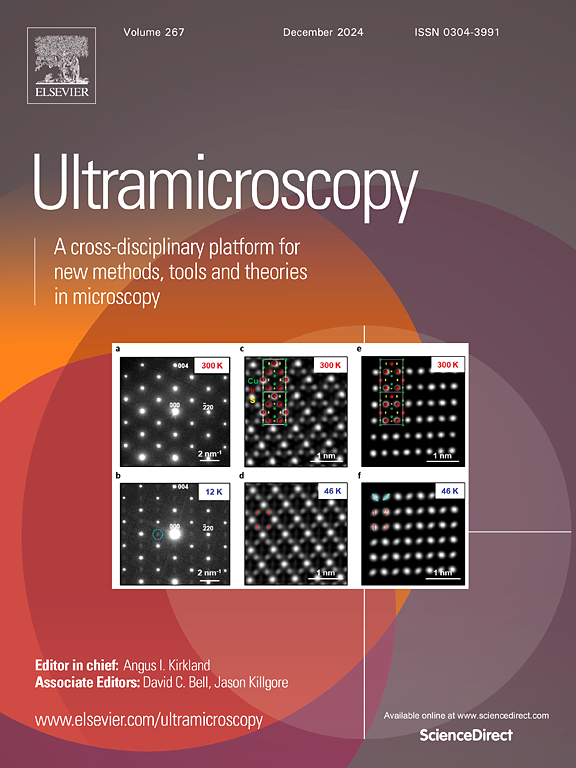A versatile machine learning workflow for high-throughput analysis of supported metal catalyst particles
IF 2
3区 工程技术
Q2 MICROSCOPY
引用次数: 0
Abstract
Accurate and efficient characterization of nanoparticles (NPs), particularly regarding particle size distribution, is essential for advancing our understanding of their structure-property relationship and facilitating their design for various applications. In this study, we introduce a novel two-stage artificial intelligence (AI)-driven workflow for NP analysis that leverages prompt engineering techniques from state-of-the-art single-stage object detection and large-scale vision transformer (ViT) architectures. This methodology is applied to transmission electron microscopy (TEM) and scanning TEM (STEM) images of heterogeneous catalysts, enabling high-resolution, high-throughput analysis of particle size distributions for supported metal catalyst NPs. The model's performance in detecting and segmenting NPs is validated across diverse heterogeneous catalyst systems, including various metals (Ru, Cu, PtCo, and Pt), supports (silica (SiO2), γ-alumina (γ-Al2O3), and carbon black), and particle diameter size distributions with mean and standard deviations ranging from 1.6 ± 0.2 nm to 9.7 ± 4.6 nm. The proposed machine learning (ML) methodology achieved an average F1 overlap score of 0.91 ± 0.01 and demonstrated the ability to disentangle overlapping NPs anchored on catalytic support materials. The segmentation accuracy is further validated using the Hausdorff distance and robust Hausdorff distance metrics, with the 90th percent of the robust Hausdorff distance showing errors within 0.4 ± 0.1 nm to 1.4 ± 0.6 nm. Our AI-assisted NP analysis workflow demonstrates robust generalization across diverse datasets and can be readily applied to similar NP segmentation tasks without requiring costly model retraining.
一个通用的机器学习工作流程,用于高通量分析负载金属催化剂颗粒
准确有效地表征纳米颗粒(NPs),特别是关于粒径分布的表征,对于提高我们对其结构-性能关系的理解和促进其各种应用的设计至关重要。在本研究中,我们引入了一种新的两阶段人工智能(AI)驱动的NP分析工作流,该工作流利用了最先进的单阶段目标检测和大规模视觉变压器(ViT)架构的快速工程技术。该方法应用于多相催化剂的透射电子显微镜(TEM)和扫描电镜(STEM)图像,实现高分辨率,高通量分析负载金属催化剂NPs的粒径分布。该模型在不同的非均相催化剂体系中检测和分割NPs的性能得到了验证,包括各种金属(Ru, Cu, PtCo和Pt),载体(二氧化硅(SiO2), γ-氧化铝(γ-Al2O3)和炭黑),以及平均和标准差范围为1.6±0.2 nm至9.7±4.6 nm的粒径分布。提出的机器学习(ML)方法实现了平均F1重叠得分为0.91±0.01,并证明了在催化支撑材料上解开重叠NPs的能力。使用Hausdorff距离和鲁棒Hausdorff距离指标进一步验证了分割精度,90%的鲁棒Hausdorff距离误差在0.4±0.1 nm至1.4±0.6 nm之间。我们的人工智能辅助NP分析工作流程在不同的数据集上展示了强大的泛化能力,可以很容易地应用于类似的NP分割任务,而不需要昂贵的模型再训练。
本文章由计算机程序翻译,如有差异,请以英文原文为准。
求助全文
约1分钟内获得全文
求助全文
来源期刊

Ultramicroscopy
工程技术-显微镜技术
CiteScore
4.60
自引率
13.60%
发文量
117
审稿时长
5.3 months
期刊介绍:
Ultramicroscopy is an established journal that provides a forum for the publication of original research papers, invited reviews and rapid communications. The scope of Ultramicroscopy is to describe advances in instrumentation, methods and theory related to all modes of microscopical imaging, diffraction and spectroscopy in the life and physical sciences.
 求助内容:
求助内容: 应助结果提醒方式:
应助结果提醒方式:


